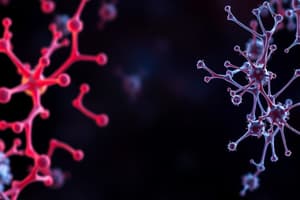Podcast
Questions and Answers
What is the primary function of antigen-presenting cells (APCs) in the adaptive immune response?
What is the primary function of antigen-presenting cells (APCs) in the adaptive immune response?
- To coordinate the immune response
- To produce antibodies to neutralize pathogens
- To directly kill infected cells
- To process and present antigens to T cells (correct)
Which of the following autoimmune diseases is characterized by chronic inflammation and tissue damage in the thyroid gland?
Which of the following autoimmune diseases is characterized by chronic inflammation and tissue damage in the thyroid gland?
- Hashimoto's thyroiditis (correct)
- Rheumatoid arthritis (RA)
- Multiple sclerosis (MS)
- Lupus
What is the primary difference between innate immunity and adaptive immunity?
What is the primary difference between innate immunity and adaptive immunity?
- Innate immunity is mediated by immune cells, while adaptive immunity is mediated by antibodies
- Innate immunity is a first line of defense, while adaptive immunity is a second line of defense
- Innate immunity is specific to certain pathogens, while adaptive immunity is non-specific
- Innate immunity is immediate, while adaptive immunity takes time to develop (correct)
What is the primary mechanism by which B cells contribute to the adaptive immune response?
What is the primary mechanism by which B cells contribute to the adaptive immune response?
What is the primary goal of vaccination in terms of adaptive immunity?
What is the primary goal of vaccination in terms of adaptive immunity?
What is the primary function of the physical barriers in the innate immune system?
What is the primary function of the physical barriers in the innate immune system?
What is the main difference between inactivated vaccines and live, attenuated vaccines?
What is the main difference between inactivated vaccines and live, attenuated vaccines?
Which of the following is NOT a type of innate immunity?
Which of the following is NOT a type of innate immunity?
What is the primary mechanism by which vaccines provide long-term protection against diseases?
What is the primary mechanism by which vaccines provide long-term protection against diseases?
Which of the following is a benefit of herd immunity?
Which of the following is a benefit of herd immunity?
Flashcards are hidden until you start studying
Study Notes
Adaptive Immunity
- Definition: The specific defense against infection and disease, mediated by immune cells and antibodies that recognize and respond to specific pathogens.
- Key components:
- T cells (T lymphocytes): recognize and respond to specific antigens, coordinate immune response
- B cells (B lymphocytes): produce antibodies to neutralize pathogens
- Antigen-presenting cells (APCs): process and present antigens to T cells
- Process:
- Antigen recognition and processing by APCs
- Activation of T cells and B cells
- Clonal expansion and differentiation of T cells and B cells
- Elimination of pathogens through cellular and humoral responses
- Types of adaptive immunity:
- Cell-mediated immunity (CMI): T cells directly kill infected cells
- Humoral immunity: B cells produce antibodies to neutralize pathogens
Autoimmune Diseases
- Definition: Conditions in which the immune system mistakenly attacks and damages the body's own tissues and organs.
- Causes:
- Genetic predisposition
- Environmental triggers (e.g., infections, toxins)
- Abnormal immune regulation
- Examples:
- Rheumatoid arthritis (RA)
- Lupus
- Hashimoto's thyroiditis
- Multiple sclerosis (MS)
- Characteristics:
- Chronic inflammation
- Tissue damage and organ dysfunction
- Immune system dysregulation
Innate Immunity
- Definition: The first line of defense against infection, providing immediate, non-specific protection against pathogens.
- Key components:
- Physical barriers (e.g., skin, mucous membranes)
- Cellular components (e.g., neutrophils, macrophages)
- Chemical components (e.g., complement system, interferons)
- Functions:
- Recognition of pathogen-associated molecular patterns (PAMPs)
- Activation of immune responses
- Elimination of pathogens through phagocytosis and inflammation
- Types of innate immunity:
- Barrier function
- Inflammatory response
- Complement system
Vaccination
- Definition: The administration of a vaccine to stimulate an immune response, providing protection against specific diseases.
- Types of vaccines:
- Inactivated vaccines (e.g., flu, HPV)
- Live, attenuated vaccines (e.g., MMR, chickenpox)
- Subunit vaccines (e.g., Hib, Hepatitis B)
- Conjugate vaccines (e.g., pneumococcal, meningococcal)
- How vaccines work:
- Introduction of antigenic material
- Recognition and processing by immune cells
- Activation of immune response and production of antibodies
- Immune memory and long-term protection
- Importance of vaccination:
- Prevention of infectious diseases
- Herd immunity
- Reduction of disease transmission and outbreaks
Adaptive Immunity
- Recognizes and responds to specific pathogens through immune cells and antibodies
- Mediated by T cells, B cells, and antigen-presenting cells (APCs)
- T cells recognize and respond to specific antigens, coordinate immune response
- B cells produce antibodies to neutralize pathogens
- APCs process and present antigens to T cells
Process of Adaptive Immunity
- Antigen recognition and processing by APCs
- Activation of T cells and B cells
- Clonal expansion and differentiation of T cells and B cells
- Elimination of pathogens through cellular and humoral responses
Types of Adaptive Immunity
- Cell-mediated immunity (CMI): T cells directly kill infected cells
- Humoral immunity: B cells produce antibodies to neutralize pathogens
Autoimmune Diseases
- Conditions where the immune system mistakenly attacks and damages the body's own tissues and organs
- Caused by genetic predisposition, environmental triggers, and abnormal immune regulation
- Examples include rheumatoid arthritis, lupus, Hashimoto's thyroiditis, and multiple sclerosis
- Characterized by chronic inflammation, tissue damage, and organ dysfunction, and immune system dysregulation
Innate Immunity
- Provides immediate, non-specific protection against pathogens
- Comprises physical barriers, cellular components, and chemical components
- Physical barriers include skin and mucous membranes
- Cellular components include neutrophils and macrophages
- Chemical components include the complement system and interferons
- Recognizes pathogen-associated molecular patterns (PAMPs) and activates immune responses
- Eliminates pathogens through phagocytosis and inflammation
Types of Innate Immunity
- Barrier function: prevents pathogen entry
- Inflammatory response: responds to pathogen presence
- Complement system: activates immune responses
Vaccination
- Administration of a vaccine to stimulate an immune response, providing protection against specific diseases
- Types of vaccines include inactivated, live, attenuated, subunit, and conjugate vaccines
- Examples of vaccines include flu, HPV, MMR, chickenpox, Hib, and Hepatitis B
- Introduction of antigenic material activates immune response and production of antibodies
- Immune memory and long-term protection against specific diseases
- Importance of vaccination includes prevention of infectious diseases, herd immunity, and reduction of disease transmission and outbreaks
Studying That Suits You
Use AI to generate personalized quizzes and flashcards to suit your learning preferences.



